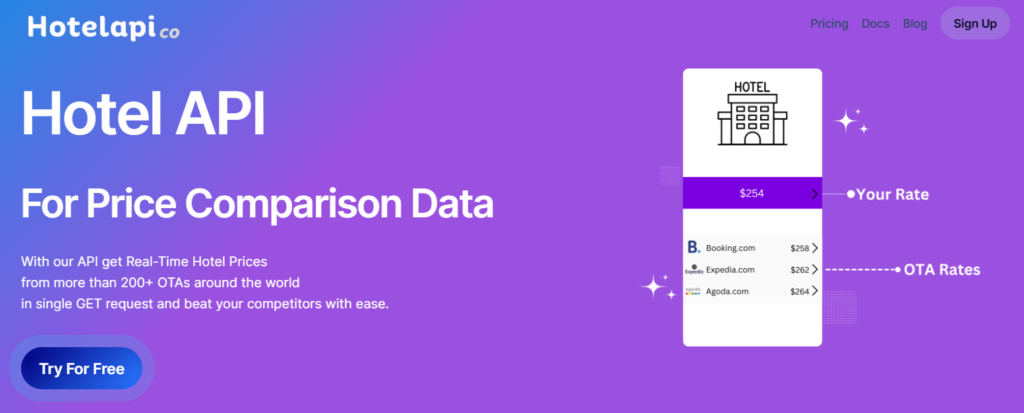
For years, businesses relied on manual data collection for price tracking—a process as labor-intensive and time-consuming.
Imagine scribbling competitor’s prices into spreadsheets or taking frequent “shopping trips” to note prices one by one, hoping the data didn’t go stale by the time decisions were made.
A report by Harvard Business Review highlights that manual data input often leads to errors, with workers spending nearly 50% of their time correcting inaccuracies. This causes them to limit opportunities for growth and agility. Imagine if this time could instead be used to grow your business.
Data-driven decision-making has been useful in the hotel industry for decades. As competition increases, hotels need to make informed choices. With advancements like hotel data API, this tedious manually collecting data approach is rapidly being replaced by more efficient methods.
But which option truly delivers the edge?
Let’s explore the pros and cons of each approach, specifically in the hotel industry, where real-time, reliable data is worth more than anything else.
The Manual Price Tracking Method: Pros and Cons
How It Works:
Manual price tracking involves manually collecting and recording competitor prices. This is often done via spreadsheets, emails, or onsite visits.
Advantages:
- Low Cost (Initially): If you’re tracking a small number of competitors or products, manual tracking may seem cost-effective as it requires no upfront software investment.
- Control: You have direct oversight of the data collection process.
Disadvantages:
- Time-Consuming: Updating prices for even a dozen competitors can eat into hours of productive time.
- Human Error: Misrecording or outdated data is a common problem.
- Scalability Issues: Tracking hundreds of hotels and price changes across multiple platforms is nearly impossible to maintain manually.
- Missed Opportunities: Frequent price fluctuations in the hospitality industry mean a manually tracked dataset quickly becomes outdated, which leads to missed chances for dynamic pricing strategies.
Hotel Data APIs: Pros and Cons
A Hotel Data API, like the one offered by HotelAPI.co, automates the entire process of collecting and analyzing pricing information across 200+ hotels, hotel chains, and OTA platforms and delivers reliable data in real-time in JSON format.

How It Works:
Hotel Data APIs use advanced scraping and integration techniques to pull real-time data from online platforms. With a few API calls, businesses can monitor thousands of competitors and price points instantly.
Advantages:
- Speed and Accuracy: APIs deliver real-time pricing data reduce the chances of error and ensure the data is always up to date.
- Scalability: Whether you’re tracking a dozen hotels or thousands, an API can handle it effortlessly.
- Integration: APIs can be integrated into existing systems for seamless updates, allowing dynamic pricing decisions based on live market conditions.
- Cost-Efficiency: Although APIs have a subscription fee, they save time and reduce labor costs, making them more affordable in the long term.
Disadvantages:
- Initial Learning Curve: Implementing and understanding APIs may require some technical knowledge.
- Upfront Cost: Compared to manual tracking, an API subscription involves upfront spending.
Key Differences Between Manual Tracking and Hotel Data APIs
| Feature | Manual Tracking | Hotel Data API |
| Time Efficiency | High labor requirement | Fully automated, real-time updates |
| Scalability | Limited to small datasets | Tracks thousands of hotels with ease |
| Cost | Low upfront, high ongoing labor costs | Higher upfront, but cost-efficient long-term |
| Accuracy | Prone to errors and delays | Highly accurate and timely |
| Insights | Minimal insights, just raw data | Actionable data analytics included |
Why Data APIs Are the Future
Consider a hotel chain planning dynamic pricing during peak holiday seasons. Using Hotel Price API, they can instantly monitor competitor rates across different regions. If competitors drop prices, they can adjust their offers within minutes, ensuring they remain competitive while maximizing profit margins. In contrast, a manual tracker might take days to reflect these changes, resulting in lost revenue.
Additionally, APIs support advanced features like monitoring reviews alongside pricing data, providing a holistic view of competitors’ positioning. This allows businesses to improve their offerings to meet customer expectations better.
Final Verdict: Which One Wins?
While manual tracking might seem sufficient for very small-scale operations or those with minimal competition, the demands of the modern hospitality industry make it clear: Hotel Data APIs are the superior choice. They combine speed, accuracy, and scalability to provide businesses with a critical edge in a hyper-competitive market.
It empowers businesses that leverage these tools to dominate in a market where real-time decision-making is crucial. If your business is committed to growth, profitability, and efficiency, embracing automation is undoubtedly the best choice.
